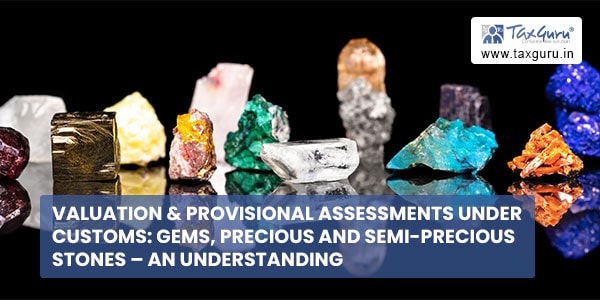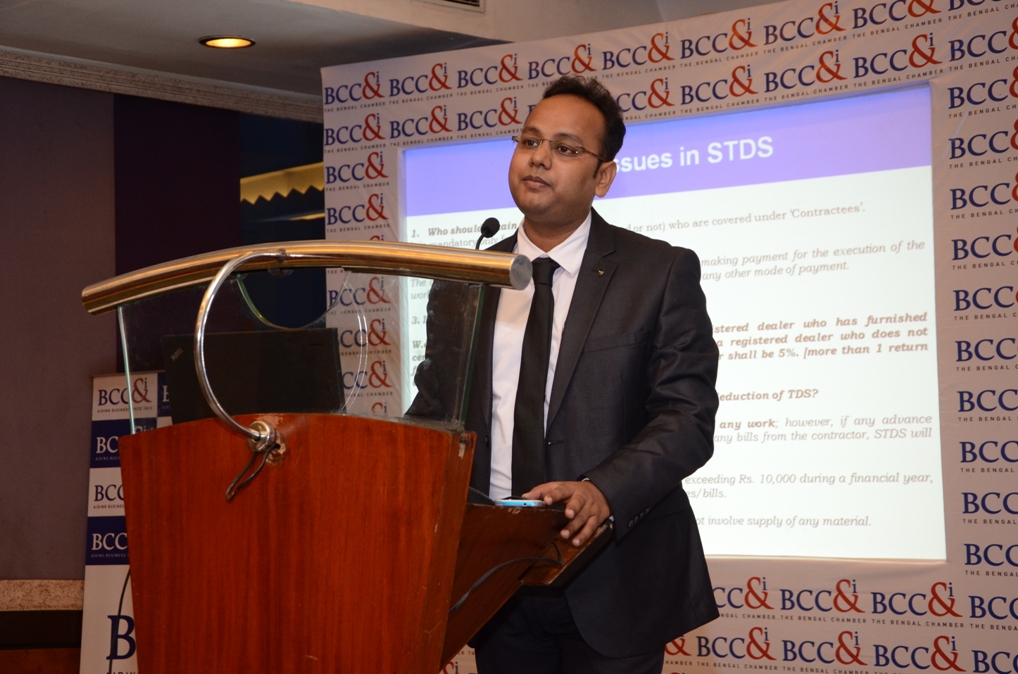Vivek Jalan and Rohit Sharma

♦ Introduction:
Valuation is one of the most crucial aspect for an organisation engaged in import and export of gems, precious and semi-precious stones considering high value transactions. This also necessitates that the value adopted for custom duty purpose is properly documented with contemporaneous evidence so that the valuation is not questioned by the customs department at the time of enquiries, audits, scrutinizes or investigation proceedings.
♦ Assessable Value:
The assessable value is required to be reported in the Bill of Entry/ Shipping Bill at the time of Import/ Export. The customs duty is being calculated on the assessable value declared by the exporter/importer.
♦ Valuation by the Customs Department:
The major concern of the customs authorities is under valuation/ over valuation of gems, precious and semi-precious stones imported/ exported by the Jewellers located in the taxable territory of India. In case the customs department have contemporaneous evidence that the value in the invoice is either fabricated or fake or that any relationship existed between the importer and the exporter, the imported gems, precious and semi-precious stones can be confiscated under the provisions of the Customs Act and penal action also may be initiated by the Customs Authorities.
♦ Transaction value as per Customs Act:
Section 14(1) of Customs Act states that ‘value’ of imported and export goods will be ‘transaction value’ of such goods i.e. the price actually paid or payable for the goods when sold for export to India for delivery at the time and place of importation, or for export from India for delivery at the time and place of exportation, where the buyer and seller of the goods are not related and price is the sole consideration for the sale, subject to such other conditions as may be specified in the rules made in this behalf.
♦ Valuation methodology of gems, precious and semi-precious stones:
The fact that diamonds or precious gems have a different cut, clarity, colour and carat makes it difficult to have a standard pricing methodology. The valuation of a gemstone is derived from the “4 C’s”: Carat, Colour, Clarity, and Cut.
i) Carat – Carat is a weight that is equivalent to one-fifth of a gram. Because gemstones are priced by the carat, carat weight must be specified to the one-hundredth of a carat.
ii) Colour – Colour is the most critical factor affecting the price of any gem variety at a given size. Colour can be separated into three basic components: hue, saturation, and tone.
iii) Clarity – Clarity refers to the internal landscape of inclusions that is inside the gem or blemishes that are on the exterior of the stone. The inclusions may be minute crystals of the same mineral, crystals of another mineral, tiny gas bubbles, small liquid filled pockets, internal fractures or cleavages, or any other visible matter inside the stone.
iv) Cut – Cut refers to the shape of the gem, the proportions of the various parts of the gem, the finishing touches such as facet relationships, and, finally, the polish. Cut is critical in creating the full potential of beauty in a gemstone. It is most critical in diamonds, where color is a less obvious consideration.
♦ Types of value of gems, precious and semi-precious stones:
Four basic types of appraisals yield four different kinds of value.
i) Replacement Value – It is the cost necessary to replace the appraised items.
ii) Fair Market Value – It is the price a willing seller and knowledgeable buyer are likely to agree upon in their local marketplace.
iii) Wholesale Value – The concessional price charged by one businessman to the other. The same is generally the price lower than price for end consumer.
iv) Liquidation or Scrap Value – If you need to sell for quick cash, you need a liquidation or scrap value appraisal.
♦ Meaning of Provisional assessment of Bill of Entry:
Sometimes, it is not possible to assess the duty due to non-availability of some relevant information/document or any other reason. Withholding clearance of goods in such cases may cause hardship to the importers by way of payment of demurrage/detention charges, disturbance in production schedule and other financial losses. To meet such exigencies, provisions have been made in section 18 of the Customs Act, 1962 to assess the duty provisionally and allow clearance of the goods by taking a bond with appropriate security.
The provisional assessment may be resorted to in following situations:
i) an importer or exporter is unable to produce any document or furnish any information necessary for the assessment of duty
ii) the customs officer deems it necessary that any imported goods or export goods to any chemical or other test for the purpose of assessment of duty thereon.
iii) the proper officer of Customs deems it necessary to make further enquiry for assessing the goods even after exporter has produced all the necessary documents and furnished full information for the assessment of duty.
On final assessment of duty in case of goods cleared for home consumption or exportation, the amount paid provisionally is adjusted against the duty finally assessed. Where a Bill of Entry or Shipping Bill is presented electronically on the Customs Automated system and is ordered to be provisionally assessed, the proper officer shall finalise the provisional assessment on the system also consequent to the procedure prescribed in the Customs (Finalisation of Provisional Assessment) Regulations, 2018.
Incase of import/export of Gems and precious/semi precious stones, the same may be done incase the customs department has contemporaneous evidences that the valuation is not correct.
♦ Certified Valuer/ Appraising Professionals:
In most of customs houses, there will be a group of appraising professionals specialized in particular commodity or commodities for assessment and import permissibility. Once after generating BOE number after registration, the said details of BOE is passed on to the computer system of appraising officer authorized for assessment. Value appraisal of imported goods by customs official could be after completion of examination of goods or before examination of goods. First check or Second Check appraisement is decided either by customs officials or by importer depends on the nature of goods imported and discretion of importer and customs officials separately.
♦ Transaction value declared in the Invoice has to be accepted:
The transaction value would have to be accepted by the Customs Department until and unless it is shown by some contemporaneous evidence that the price declared in the invoice was not in accordance with the provisions of the Customs Act. In case of COMMISSIONER OF CUSTOMS, MUMBAI VERSUS MAHALAXMI GEMS 2008 (9) TMI 67 – SUPREME COURT the honorable Supreme Court held that “the department has failed to show from any contemporaneous evidence that the invoices were either fabricated or fake or that any relationship existed between the importer and the exporter. We entirely agree with the view taken by the Tribunal that the transaction value has to be accepted until and unless it is shown by some contemporaneous evidence that the price declared in the invoice was not the correct price.”
The basis for the enhancement of the value ordered by the Commissioner is the opinion of the appraising officers of the custom house and the opinion of two members of a trade panel that was constituted in the above mentioned case.
♦ Meaning of contemporaneous evidence:
For the Importer/ Exporter:
(i) The Invoice issued by the exporter.
(ii) Replenishment Licence from the Relevant authority
(iii) Replenishment Authorisation for Gems from the Relevant authority
(iv) Bill of Entry
(v) Origin Certificate
(vi) Air Waybill
For the Customs Authorities:
(i) Information received from the Intelligence authorities
(ii) Appraisers Valuation Report
(iii) Trade Panel Report
Exemption from Custom Duty and Additional Duty:
It is to be noted that Custom Duty and Additional Duty on import of raw pearls, natural or cultured, and precious or semi-precious stones (other than rough diamonds), unset and uncut, falling under Chapter 71 of the First Schedule to the Customs Tariff Act, 1975 (51 of 1975), is exempt vide N. No. 60/2002-Customs dated 07th June 2002. subject to the condition that imports are made under a Replenishment Licence or Replenishment Authorisation for Gems issued under, and in accordance with, the Foreign Trade Policy.
Conclusion:
Foregoing discussion makes it clear that there could be possibilities of taking different value for same gems, precious and semi-precious stones when removed for different purposes. There could be many other possibilities where special provision of valuation may need to be applied. It is important to have proper documentations of the basis and manner of taking a particular value as there are frequent changes in the value of gems, precious and semi-precious stones and it may not be easy to justify the prices without contemporaneous evidence.
Further, incase of provisional assessment of Bills on Entries, it is important in the case of Gems and Precious/Semi-Precious Stones to assimilate contemporaneous evidences before approaching the Customs Authorities for Finalisation of Assessments.
BRIEF ABOUT THE AUTHORS:

Vivek Jalan is a Chartered Accountant & a qualified L.LM (Constitutional Law) & LL.B. He is the Founder & Partner of Tax Connect Advisory Services LLP. He is the Chairperson – Indirect Tax Core Committee of The Confederation of Indian Industries (CII) – Economic Affairs & Taxation Committee – ER. He is the Chairman of The Ease of Doing Business Committee of The Bengal Chamber of Commerce and Industry.
He is a regular Columnist and guest expert in Economic Times, Times of India, Dalal Street Journal, Money Control, Live mint, CNBC, Hindustan Times, Zee Business, Financial Express, other dailies and business magazines like Business Today, etc. He is also a guest expert on Taxation matters in All India Radio and other media platforms. He is the Editor of Weekly Bulletin TAX CONNECT, a publication on Indirect Taxes and Direct Taxes which reaches more than 70000 professionals.
He is also a visiting faculty for Taxes in The Confederation of Indian Industries (CII), The Institute Of Chartered Accountants of India, Institute of Cost Accountants of India, Indian Institute of Foreign Trade, The Bengal Chamber of Commerce and Industry, The Indian Chamber of Commerce and other Business Forums. He has also delivered Lectures at various Government Taxation Forums including the CGST & SGST Departments across the country.
He has worked as a Finance Manager in ITC Ltd. and Chief Compliance Officer with IntraSoft Technologies Ltd. He has more than 15 years of experience in the field of Indirect & Direct Taxation. He was also an All India Rank holder in CA Final Examination conducted by the Institute of Chartered Accountants of India.
His Books on taxation include the following –
- GST PLEADING & PRACTISE – AUGUST 2021
- COMMENTARY ON UNION BUDGET 2021 – Feb 2021
- SECTION-WISE COMPENDIUM ON GST – Oct 2020
- INTEGRATED APPROACH TO GST E-INVOICE, E-WAYBILL & RETURN E-FILING – Oct 2020
- COMMENTARY ON UNION BUDGET 2020– Feb 2020
- COMMENTARY ON DIRECT TAX VIVAAD SE VISHWAS SCCHEME – Feb 2020
- SECTION-WISE COMMENTARY ON GST – SEPTEMBER 2018
- HOW TO HANDLE GST-TDS, GST-TCS, GST AUDIT & GST ANNUAL RETURN – NOVEMBER 2018
- COMMENTARY ON UNION BUDGET 2019 – July 2019
- WITHDRAWAL OF LEGAL TENDER 2016
- COMMENTARY ON UNION BUDGET 2017
- A COMPENDIUM ON GST W.E.F. 1ST JULY 2017
- GST MODEL LAW (NOVEMBER 2016) & BUSINESS PROCESSES – A TECHNICAL COMMENTARY
- GST MODEL LAW (JUNE 2016) & BUSINESS PROCESSES – A TECHNICAL COMMENTARY
- “SERVICE TAX AND VAT IN WORKS CONTRACT: A COMPREHENSIVE TECHNICAL GUIDE”.
He is a regular speaker at various professional forums on the various key areas in Indirect & Direct Taxes and has delivered more than 300 lectures on various topics under GST, Customs, Foreign Trade Policy of India, Income Tax, etc.
Mr Rohit Sharma has rich experience of more than 10 years in Indirect & Direct Taxes in India and application of Accounting Standards. He is presently serving as a Manager at M/s TAX CONNECT ADVISORY SERVICES LLP. He has done extensive study in Indirect Taxation and is now handling the entire gamut of GST Services on behalf of Tax Connect in various Manufacturing Organizations, Service Sector companies & PSUs.





